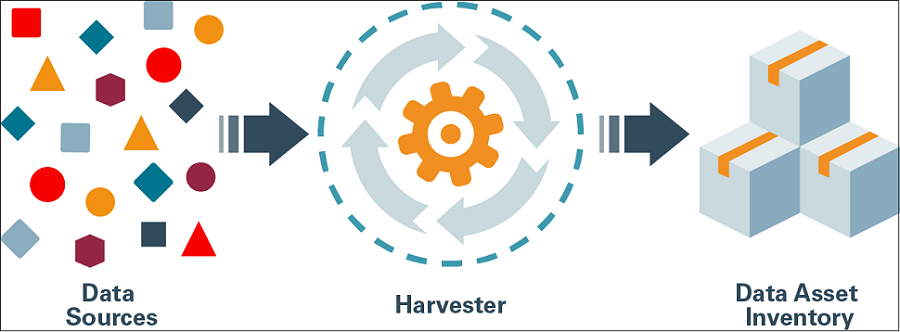Harvesting Technical Metadata
Extract data structure information from your data sources into your data catalog repository.
The process of extracting data structure information is known as harvesting.
What is a Data Asset?
To harvest your data source, you need to register your data source as a data asset in your data catalog instance. A data asset is any physical data store or stream of data such as a database, a cloud storage container, or a message stream.
When you harvest a data asset, the Data Catalog harvester extracts, standardizes, and indexes metadata information from the data asset to create a unified and searchable repository in the data catalog. You then browse or explore the data catalog to view the harvested data entities and attributes to annotate and enrich the data assets.
Harvesting a data source involves the following steps:
- Identify connectivity details to connect to the data source.
- Create a data asset.
- Add a connection to your data asset.
- Harvest the data asset.
Supported Data Sources for Data Assets
You use the following data sources (accessible using public or private IPs) to create data assets in Data Catalog.
This is a list of supported data sources, not certified data sources.
| Data Source Type | Version |
|---|---|
| Oracle Database | 12.1 |
| 12.2 | |
| 18 | |
| 19 | |
| 20 | |
| 21 | |
| Oracle Database on Oracle Cloud Infrastructure | 12.1 |
| 12.2 | |
| 18 | |
| 19 | |
| Exadata DB Systems | 12.1 |
| 12.2 | |
| 18 | |
| 19 | |
| Oracle Cloud Infrastructure Object Storage | Latest |
| Autonomous Database for Analytics and Data Warehousing | 18c/19c |
| Autonomous Database for Transaction Processing and Mixed Workloads | 18c/19c |
| MySQL | 8.0.x |
| OCI HeatWave Service | 8.0.25-u3-cloud |
| PostgreSQL | 10.1 |
| 9.6, 9.5, 9.4, 9.3, 9.2, 9.1, and 9.0 | |
| 8.4, 8.3, and 8.2 | |
| Apache Hive | CDH 5.4 and higher |
| Apache 1.0, 2.0, 3.0 and higher | |
| Microsoft SQL Server | 2019 |
| 2017 | |
| 2016 Service Pack 2 | |
| 2014 Service Pack 3 | |
| 2012 Service Pack 4 | |
| IBM DB2 LUW (DB2 for Linux, UNIX and Windows) | 10.5.0.11 |
| 11.5.5.0 | |
| IBM DB2 AS400 | 7.1 and higher |
| Apache Kafka | 2.12-2.3.0 |
| Microsoft Azure SQL Database | 12.00.2000 |
You can also connect to on-premises data sources that are connected to Oracle Cloud Infrastructure Virtual Cloud Networks (VCNs).
Depending on the type of data asset you create, you use different data structures to browse the data entities. For example, if you create an Oracle Database data asset, you browse through database objects to review the table and view data entities.
In data assets of type Oracle Database or Autonomous Databases if the database version is Oracle Database 12c and above, Data Catalog harvester doesn't harvest the Oracle maintained schemas and other common user schemas.
Harvested Objects for Data Sources
The harvested objects for different data sources are listed in the following table:
| Data Source | Harvested Objects |
|---|---|
| Apache Hive |
|
| Apache Kafka |
|
| Oracle Cloud Infrastructure Object Storage |
|
| OCI Data Catalog Metastore |
|
| Autonomous Data Warehouse |
|
| Autonomous Transaction Processing | |
| IBM DB2 | |
| Microsoft Azure SQL database | |
| Microsoft SQL Server | |
| MySQL | |
| Oracle Database | |
| PostgreSQL |
Supported File Types
The following file types are supported for Oracle Object Storage:
-
Comma-Separated Value (CSV) files (
.csv,.csv.gz)Note
The supported separators are,(comma),\t(tab),|(vertical bar),;(semicolon). -
XML files (
.xml,.xsd) -
Avro files (
.avro,.avro.gz) -
Excel files (
.xls,.xlsx) -
Apache Parquet files (
.parquet,.pq) -
Apache ORC files (
.orc) -
Simple JSON files (
.json,.json.gz)
If you choose to harvest unsupported file types, the Data Catalog harvester extracts only the basic information from those files, such as names and paths.
Data Entities and Attributes
A data asset contains one or more data entities. A data entity is a collection of data such as a database table or view, or a single logical file. A data entity normally has many attributes that describe its data. An attribute describes a data item with a name and data type.
| Data Asset | Data Entities | Attributes |
|---|---|---|
| Database | Tables and Views | Columns |
| File Container | Files | Fields |
| Data Stream | Event or Topic or Payload | Keys |
